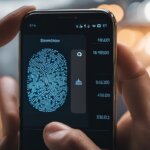Table of Contents
In today’s digital age, biometric data has become a buzzword in the realm of security and personal identification. But what exactly is biometric data, and why is it critical? Simply put, biometric data refers to measurements of unique physical or behavioral characteristics that can be used to identify an individual. These characteristics include fingerprints, facial features, iris patterns, voiceprints, and more.
Biometric data has several advantages over traditional authentication methods, such as passwords and PINs, as it is more secure and accurate. Additionally, it makes identification quicker, more convenient, and less prone to fraud. As a result, biometric data has become an integral part of various industries, including law enforcement, financial institutions, healthcare, and access control systems.
In this article, we will explore what biometric data is, its various types, its applications, and its benefits. We will also discuss how biometric data is captured and used, along with the potential challenges and risks associated with it. By the end of this article, you will have a comprehensive understanding of biometric data and its significance in our digital world.
Key Takeaways
- Biometric data refers to unique physical or behavioral characteristics used for identification.
- Biometric data is more secure and accurate than traditional authentication methods.
- Biometric data is used in various industries, including law enforcement, financial institutions, healthcare, and access control systems.
- Biometric data has several benefits, such as increased security, convenience, and reduced fraud.
- Understanding biometric data is critical for ensuring a safer and more efficient digital future.
Defining Biometric Data
Biometric data refers to the measurable physical or behavioral characteristics of an individual that are unique and can be used for personal identification. Biometric data encompasses a range of biological traits, including:
- Fingerprints – the pattern of ridges and furrows on the pads of fingers and thumbs
- Facial features – the distinctive physical features of an individual’s face, such as the shape of the eyes, nose, and mouth
- Iris patterns – the unique characteristics of the coloured part of the eye
- Voiceprints – the acoustic patterns of an individual’s voice
- Hand geometry – the shape and size of an individual’s hand and fingers
- Retina scans – the unique patterns of blood vessels at the back of the eye
- Signature dynamics – the behavioral characteristics of an individual’s signature
Each biometric modality has advantages and limitations in terms of accuracy, speed, and level of intrusion. By combining different types of biometric data, it is possible to create a more comprehensive and accurate identity profile for an individual.
In 2019, a study by the National Institute of Standards and Technology (NIST) found that multimodal biometric systems (using two or more biometric modalities) can achieve accuracy rates of up to 99.99% in identity verification.
Biometric Data as Personal Data
Biometric data is considered a type of personal data under data protection laws, such as the UK Data Protection Act 2018 and the EU General Data Protection Regulation (GDPR). This means that organizations that collect, store, and process biometric data must comply with strict rules on data protection and privacy, such as obtaining explicit consent, implementing appropriate security measures, and providing individuals with the right to access and delete their data.
Applications and Benefits of Biometric Data
Biometric data has a wide range of applications across different sectors, offering numerous benefits to both individuals and organizations.
Law Enforcement
In the field of law enforcement, biometric data is used to quickly and accurately identify suspects, track criminals, and solve crimes.
For instance, facial recognition technology can be used to match images with a database of criminal records, leading to the arrest of dangerous criminals and terrorists. Fingerprint scanners can also help police officers to identify and track down suspects.
Such technologies can potentially reduce crime rates and increase public safety, ensuring that criminals are brought to justice and innocent people are protected.
Financial Institutions
Financial institutions use biometric data to authenticate customer identities, prevent fraud, and enhance security.
For example, banks can use voice recognition technology to verify the identity of customers over the phone or use facial recognition to authorize online transactions. Biometric authentication can prevent unauthorized access to accounts and prevent identity theft, saving individuals and organizations time and money.
Healthcare
In the healthcare industry, biometric data can be used to improve patient care, ensure accurate diagnosis, and prevent medical errors.
Wearable biometric devices can track patient health data, allowing doctors to monitor and manage chronic health conditions in real-time. Biometric authentication can also help to prevent medical identity theft and ensure that patient medical records are accessed only by authorized personnel.
Access Control Systems
Access control systems use biometric data to provide secure and convenient access to buildings, rooms, and devices.
Fingerprint scanners, iris scanners, and facial recognition technology can be used to grant access to individuals with the proper clearance, while denying access to unauthorized persons. Biometric access control systems can prevent theft, unauthorized access, and ensure that restricted areas are protected.
Overall, biometric data applications provide numerous benefits such as increased security, improved accuracy, convenience, and reduced fraud. From law enforcement to healthcare, such applications enhance both personal and organizational safety while streamlining processes and improving outcomes.
Conclusion
To sum up, biometric data plays a crucial role in ensuring security and personal identification in today’s digital age. By capturing unique physical or behavioral traits of individuals, it offers increased accuracy and convenience, reducing the risk of fraud and identity theft. The applications of biometric data are vast, ranging from law enforcement to healthcare to access control systems. Utilizing biometric data can lead to a safer and more efficient digital future.
FAQ
What is biometric data?
Biometric data refers to unique physical or behavioral characteristics of individuals. It includes fingerprints, facial features, iris patterns, voiceprints, and more.
Why is biometric data important?
Biometric data enhances security and personal identification by providing highly accurate and unique identification measures that cannot be easily replicated or stolen.
What are the types of biometric data?
The types of biometric data include fingerprints, facial features, iris patterns, voiceprints, and other physical or behavioral characteristics that are specific to an individual.
What are the applications of biometric data?
Biometric data is used in various sectors such as law enforcement, financial institutions, healthcare, and access control systems. It helps to ensure secure transactions, restrict unauthorized access, and enhance identification processes.
What are the benefits of biometric data?
Biometric data offers several benefits, including increased security, improved accuracy in identification processes, convenience, and reduced chances of fraud or identity theft.













